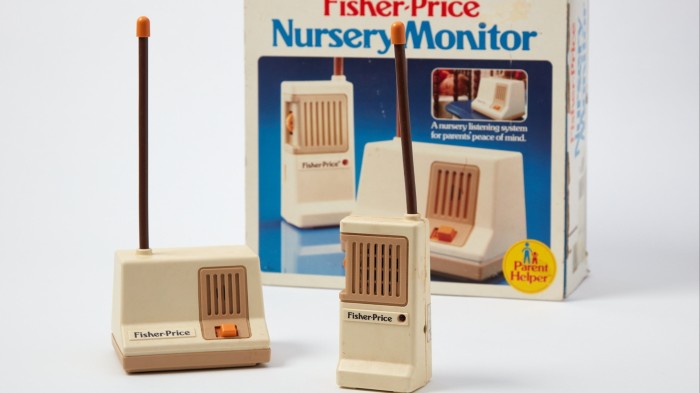Stay informed with free updates
Simply sign up to the Arts myFT Digest — delivered directly to your inbox.
In 1938, the Third Reich began awarding German women the “Cross of Honour of the German Mother”, a medal ranked according to how many times their wombs had produced live-born children (not the Jewish ones, of course, nor the Romani). If they managed four, they got bronze. A few more, silver. Gold was awarded rarely, only to those who’d created eight or more “Aryan” children in the low dark of their bodies, foetal skeletons grown like so many machine guns in a factory.
The blue and gold Nazi cross of motherhood is missing from Designing Motherhood at New York’s Museum of Art and Design. No matter — over the century and a half of fascinating reproductive design illustrated in the exhibition, from the darkest sorts of medical-misogynist control to the most liberating breast pump, the motherhood medal casts a long shadow, darkening even our American present.
The eugenicists of the 1930s understood that motherhood is, and has always been, the fulcrum of human culture. Win the story of what mothers are and should do and, eventually, you win the future. Sometimes that story is made of words. Sometimes well-designed objects. Sometimes it’s made of flesh itself.
Visitors in New York walk through a stylish display of more than 250 examples of human techne, each in their own way shaping the story of motherhood: from the forceps and oxidised speculums of the Victorian obstetrician to the whimsical plastic blister pack of the Pill, from a glass Stork nursing bottle from the 1930s (replete with a raised design of an Easter rabbit wearing some sort of natty tuxedo) to the 1980s beige and orange Fisher-Price baby monitor.
All of these we’re invited to consider in light of the many cultural anxieties that accompanied their production. The kidnapping of 20-month-old Charles Lindbergh was the initial trigger for the invention of the baby monitor in 1932, and they massively proliferated later, as a wave of women entered the workforce in greater numbers in the 1970s and ’80s, producing a feminine domestic life that was nevertheless expected to be even more productive and ever-vigilant, tethered even as the child sleeps.
While the breast pump was invented as a medical tool for mothers who had difficulty directly breastfeeding (a shockingly common condition), it was also wielded during the rise of the “breast is best” movement as both salve and cudgel for working mothers (and continues to be so). No matter that American mothers are offered, by federal law, only 12 weeks of unpaid maternity leave, for which they only qualify if they have worked for the same company for at least a year. A nursing mother can spend up to 2,200 hours breastfeeding in the first year of a child’s life — that is, 55 full-time weeks’ worth of labour.

The exhibit has toured in various iterations before, from the tech-hallowed halls of the Gates Discovery Center in Seattle (I saw it there myself in 2023), to Houston, Texas, where it reached last November — surely a fascinating moment of curatorial tension, given the state’s near-total ban on abortion. The show’s New York iteration was booked well before an elected American president, against the consistent and overwhelming opinion of international medical authorities and the scientific research community, would blame pregnant women taking the painkiller Tylenol for a rise in autism diagnoses. It is, let’s say, very now to think carefully about how we should care for and talk about pregnant, birthing and post-partum bodies.
Padding quietly through the gallery’s well-buffed floors, you’ll see a giddy array of speculative design, video, political documents, receipts, pamphlets, a bevy of tools (both medical and not), and contemporary artworks that interrogate maternal suffering even as they celebrate the many bizarre and luscious qualia of having bodies like these that can do such wondrous things.

The gorgeous work of Ani Liu interrogates her own maternal labour through things like delightfully sci-fi tangles of breast milk tubing or “pregnancy menswear”, reinterpreting what “maternity fashion” might be for pregnant folk who don’t identify as women. That piece is rendered through silk and boning as a kind of 3D sketch in suspension, a fuzzy in-between of what could be realised, but isn’t; gender as a thing that’s dreamt and worn in a loose halo around our mammalian bodies.
And therein lies the rub: it quickly becomes insufficient to walk through an exhibit like this thinking you’re either on a heroine’s journey or a little shop of horrors. It’s always both: not all of these designs were invented for the purpose of aiding reproductive health or even to relieve suffering. Much grew out of the 20th century’s wars: early baby monitors used bands of radio that transmitted along a house’s electrical wires, a technology previously used for spying. Medical uses for plastics largely grew out of trauma medicine on battlefields. It remains true that things that are designed for death are quickly repurposed for the living. One assumes the next version of this exhibition will need to add a bottle of Tylenol. No title, no notes.
To March 15, madmuseum.org
Find out about our latest stories first — follow FT Weekend on Instagram, Bluesky and X, and sign up to receive the FT Weekend newsletter every Saturday morning









